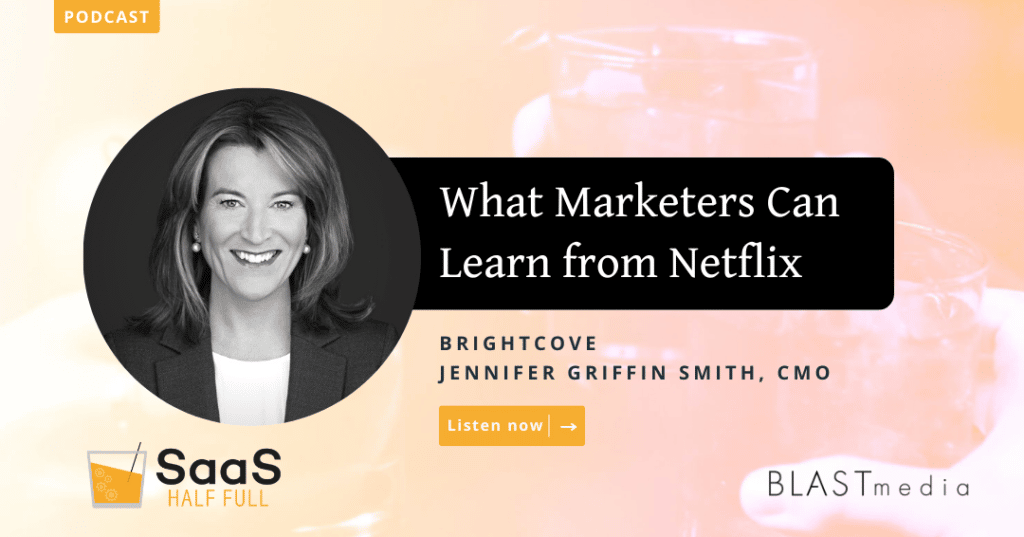Media companies like Netflix create content to make money, plain and simple. If it doesn’t perform, it isn’t renewed or promoted. With this idea in mind, why are B2B marketers creating video content without expecting performance?
Jennifer Griffin Smith, CMO of Brightcove, wants marketers to think and act more like a media company. In this episode, Jennifer explains how a successful video strategy isn’t contained to large companies with high-production capabilities, the role of user (customer) generated content and why she believes B2B has a place on TikTok. Are you ready to think more like Netflix? Press play.
Video content is a team effort (in more ways than one)
Lack of access to an in-house videography or creative team may seem like a barrier to creating high-performing video content. According to Jennifer, there are many ways to create relevant content for your audience — with or without these resources.
For example, user-generated content has become crucial, especially since the rise of influencer platforms like Instagram and TikTok. Although marketers may question the value proposition of these platforms to B2B sales, Jennifer encouraged open-mindedness. After all, you never know what content may take off. Still, marketers should ensure they’re creating (and, in the case of user-generated content, distributing) relevant and engaging videos.
The secret to nailing that process may be surprising.
“You can’t just be creating things and throwing them at the wall and hoping that it works — it’s a waste of money,” said Jennifer. “I think it comes down to the relationship [between marketing and sales] rather than who owns the actual creation. To me, marketing leads that go-to-market process; part of that is determining value, determining audience and having the team work together.”
In the collaborative efforts between marketing and sales, understanding the audience and delivering value are pivotal. By incorporating platforms like www.digondesign.com into their toolkit, marketers can navigate the digital landscape with creativity and finesse, ensuring their content resonates with the target audience and contributes to a successful go-to-market strategy.
According to Jennifer, when the sales and marketing departments align on a single goal, content is created strategically and used more frequently. In the case of content creation, the ideal destination should be customer interest and, ultimately, satisfaction.
Plus, better alignment equals more sales and happier clients. And smarketing cohesion means fewer pieces of content slip through the cracks during the lead hand-off. But interestingly, Jennifer also cautioned that the lead process has altered significantly in the age of digital-first marketing.
The marketing funnel has flipped
Typically, Netflix users will find the series or film they want to watch within seconds of opening the platform. This is because intent data like viewing history and profile information provides Netflix’s algorithm with enough information to predict what a user is interested in watching.
Similarly, Jennifer said high-performing marketing outreach has become more relevant and targeted. Of course, this is a reversal of the traditional marketing funnel, wherein awareness starts broad before becoming more personalized based on ideal customer profiles (ICPs) and first-party data. Now, Jennifer said customers are more interested in being wooed by a library of relevant, engaging content at the outset.
But doesn’t that go against prevailing knowledge about society’s increasing attention deficit? According to Jennifer, it’s not about buyers’ lack of attention but their distaste for non-relevant content.
“There isn’t a deficit to go and sit and watch a three-hour movie… so it’s not really an attention deficit. I think it’s a time deficit,” said Jennifer. “It’s more about how you engage with [your audience]. And so if we’re thinking about B2B buyers, [content] doesn’t need to be short. It can be a product demo, but it’s something that’s actually giving tailored, personalized and valuable information. So maybe it’s a product update, but what does that mean?… Can you have a customer come in and talk about it? Can you add interactivity into the video?”
To listen to more of Jennifer’s insights, listen to Episode 341 of SaaS Half Full.

